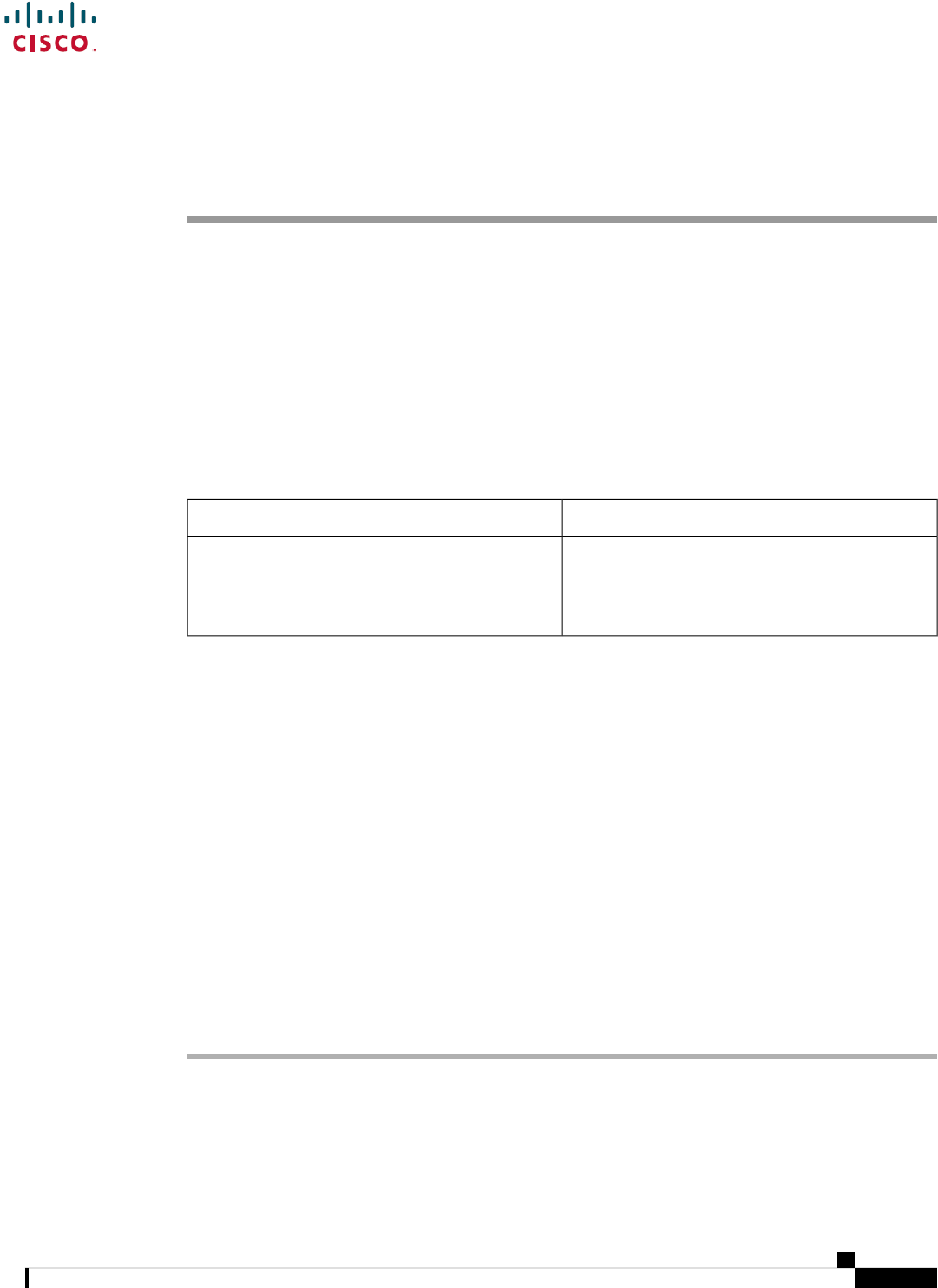
Cisco IP Phone 6821 Multiplatform Phones
Release Notes for Firmware Release 11.3(1)SR4
First Published: 2021-02-26
Release Notes
This release contains only internal changes to optimize manufacturing process.
Use these release notes with the Cisco IP Phone 6821 Multiplatform Phones running SIP Firmware Release
11.3(1)SR4.
The following table describes the individual phone requirements.
Support RequirementsPhone
Cisco BroadWorks 23.0
MetaSphere CFS version 9.5
Asterisk 11.0
Cisco IP Phone 6821 Multiplatform Phones
New and Changed Features
This release is a maintenance release and doesn't contain any new or enhanced features.
Cisco IP Phone 6800 Series Documentation
See the publications that are specific to your language, phone model, and multiplatform firmware release.
Navigate from the following Uniform Resource Locator (URL):
https://www.cisco.com/c/en/us/support/collaboration-endpoints/ip-phone-6800-series-multiplatform-firmware/
tsd-products-support-series-home.html
Upgrade the Firmware
You can upgrade the phone firmware with TFTP, HTTP, or HTTPS. After the upgrade completes, the phone
reboots automatically.
Procedure
Step 1 Click this link:
https://software.cisco.com/download/home/286318380
Cisco IP Phone 6821 Multiplatform Phones Release Notes for Firmware Release 11.3(1)SR4
1

On the Software Download web page that is displayed, ensure that IP Phone6800 Series with Multiplatform
Firmware is selected in the middle pane.
Step 2 Select your phone model in the right pane.
Step 3 On the next page that is displayed, select Multiplatform Firmware.
Step 4 Under All Release, select the MPPv11 folder, then select the 11.3.1 MSR4-1 folder.
Step 5 (Optional) Place your mouse pointer on the file name to see the file details and checksum values.
Step 6 Download the file cmterm-6821.11-3-1MSR4-1_REL.zip.
Step 7 Click Accept License Agreement.
Step 8 Unzip the file and place the files in the appropriate location on your upgrade server.
The appropriate location is the TFTP, HTTP, or HTTPS download folder, depending on the protocol that you
want to use for the upgrade.
Step 9 Upgrade the phone firmware with one of these methods.
• Upgrade the phone firmware from the phone administration web page:
a. On the phone administration web page, go to Admin Login > Advanced, Voice > Provisioning >
Firmware Upgrade.
b. In the Upgrade Rule field, enter the load file URL as described below.
Load file URL format:
<upgrade protocol>://<upgrade server ip
address>[:<port>]>/<path>/<file name>.loads
Examples:
http://10.73.10.223/firmware/sip6821.11-3-1MSR4-1.loads
https://server.domain.com/firmware/sip6821.11-3-1MSR4-1.loads
c. Click Submit All Changes.
• Upgrade the phone firmware directly from your web browser:
In the address bar of your web browser, enter the phone upgrade URL as described below.
Phone upgrade URL format:
<phone protocol>://<phone ip address[:port]>/admin/upgrade?<load file
URL>
Load file URL format:
<upgrade protocol>://<upgrade server ip address>[:<port>]>/<path>/<file
name>.loads
Examples:
https://10.74.10.225/admin/upgrade?http://10.73.10.223/firmware/sip6821.11-3-1MSR4-1.loads
https://10.74.10.225/admin/upgrade?https://server.domain.com/firmware/sip6821.11-3-1MSR4-1.loads
Cisco IP Phone 6821 Multiplatform Phones Release Notes for Firmware Release 11.3(1)SR4
2
Upgrade the Firmware

Specify the <file name>.loads file in the URL. The <file name>.zip file contains other
files.
Note
Limitations and Restrictions
Phone Behavior During Times of Network Congestion
Anything that degrades network performance can affect phone audio and, in some cases, can cause a call to
drop. Sources of network degradation can include, but are not limited to, the following activities:
• Administrative tasks, such as an internal port scan or security scan
• Attacks that occur on your network, such as a Denial of Service attack
View Caveats
This release doesn't contain any open or resolved caveats.
Cisco IP Phone Firmware Support Policy
For information on the support policy for phones, see https://cisco.com/go/phonefirmwaresupport.
Cisco IP Phone 6821 Multiplatform Phones Release Notes for Firmware Release 11.3(1)SR4
3
Limitations and Restrictions

THE SPECIFICATIONS AND INFORMATION REGARDING THE PRODUCTS IN THIS MANUAL ARE SUBJECT TO CHANGE WITHOUT NOTICE. ALL STATEMENTS,
INFORMATION, AND RECOMMENDATIONS IN THIS MANUAL ARE BELIEVED TO BE ACCURATE BUT ARE PRESENTED WITHOUT WARRANTY OF ANY KIND,
EXPRESS OR IMPLIED. USERS MUST TAKE FULL RESPONSIBILITY FOR THEIR APPLICATION OF ANY PRODUCTS.
THE SOFTWARE LICENSE AND LIMITED WARRANTY FOR THE ACCOMPANYING PRODUCT ARE SET FORTH IN THE INFORMATION PACKET THAT SHIPPED WITH
THE PRODUCT AND ARE INCORPORATED HEREIN BY THIS REFERENCE. IF YOU ARE UNABLE TO LOCATE THE SOFTWARE LICENSE OR LIMITED WARRANTY,
CONTACT YOUR CISCO REPRESENTATIVE FOR A COPY.
The following information is for FCC compliance of Class A devices: This equipment has been tested and found to comply with the limits for a Class A digital device, pursuant to part 15
of the FCC rules. These limits are designed to provide reasonable protection against harmful interference when the equipment is operated in a commercial environment. This equipment
generates, uses, and can radiate radio-frequency energy and, if not installed and used in accordance with the instruction manual, may cause harmful interference to radio communications.
Operation of this equipment in a residential area is likely to cause harmful interference, in which case users will be required to correct the interference at their own expense.
The following information is for FCC compliance of Class B devices: This equipment has been tested and found to comply with the limits for a Class B digital device, pursuant to part 15 of
the FCC rules. These limits are designed to provide reasonable protection against harmful interference in a residential installation. This equipment generates, uses and can radiate radio
frequency energy and, if not installed and used in accordance with the instructions, may cause harmful interference to radio communications. However, there is no guarantee that interference
will not occur in a particular installation. If the equipment causes interference to radio or television reception, which can be determined by turning the equipment off and on, users are
encouraged to try to correct the interference by using one or more of the following measures:
• Reorient or relocate the receiving antenna.
• Increase the separation between the equipment and receiver.
• Connect the equipment into an outlet on a circuit different from that to which the receiver is connected.
• Consult the dealer or an experienced radio/TV technician for help.
Modifications to this product not authorized by Cisco could void the FCC approval and negate your authority to operate the product.
The Cisco implementation of TCP header compression is an adaptation of a program developed by the University of California, Berkeley (UCB) as part of UCB’s public domain version of
the UNIX operating system. All rights reserved. Copyright
©
1981, Regents of the University of California.
NOTWITHSTANDING ANY OTHER WARRANTY HEREIN, ALL DOCUMENT FILES AND SOFTWARE OF THESE SUPPLIERS ARE PROVIDED "AS IS" WITH ALL FAULTS.
CISCO AND THE ABOVE-NAMED SUPPLIERS DISCLAIM ALL WARRANTIES, EXPRESSED OR IMPLIED, INCLUDING, WITHOUT LIMITATION, THOSE OF
MERCHANTABILITY, FITNESS FOR A PARTICULAR PURPOSE AND NONINFRINGEMENT OR ARISING FROM A COURSE OF DEALING, USAGE, OR TRADE PRACTICE.
IN NO EVENT SHALL CISCO OR ITS SUPPLIERS BE LIABLE FOR ANY INDIRECT, SPECIAL, CONSEQUENTIAL, OR INCIDENTAL DAMAGES, INCLUDING, WITHOUT
LIMITATION, LOST PROFITS OR LOSS OR DAMAGE TO DATA ARISING OUT OF THE USE OR INABILITY TO USE THIS MANUAL, EVEN IF CISCO OR ITS SUPPLIERS
HAVE BEEN ADVISED OF THE POSSIBILITY OF SUCH DAMAGES.
Any Internet Protocol (IP) addresses and phone numbers used in this document are not intended to be actual addresses and phone numbers. Any examples, command display output, network
topology diagrams, and other figures included in the document are shown for illustrative purposes only. Any use of actual IP addresses or phone numbers in illustrative content is unintentional
and coincidental.
All printed copies and duplicate soft copies of this document are considered uncontrolled. See the current online version for the latest version.
Cisco has more than 200 offices worldwide. Addresses and phone numbers are listed on the Cisco website at www.cisco.com/go/offices.
Cisco and the Cisco logo are trademarks or registered trademarks of Cisco and/or its affiliates in the U.S. and other countries. To view a list of Cisco trademarks, go to this URL:
https://www.cisco.com/c/en/us/about/legal/trademarks.html. Third-party trademarks mentioned are the property of their respective owners. The use of the word partner does not imply a
partnership relationship between Cisco and any other company. (1721R)
©
2021 Cisco Systems, Inc. All rights reserved.

©
2021 Cisco Systems, Inc. All rights reserved.
